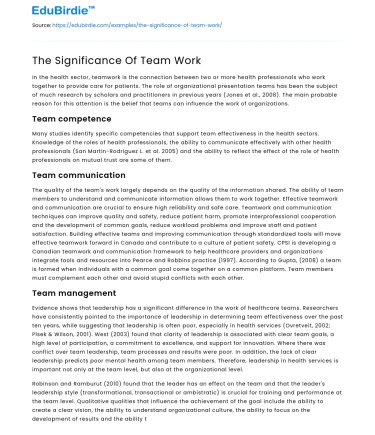In the health sector, teamwork is the connection between two or more health professionals who work together to provide care for patients. The role of organizational presentation teams has been the subject of much research by scholars and practitioners in previous years (Jones et al., 2008). The main probable reason for this attention is the belief that teams can influence the work of organizations.
Team competence
Many studies identify specific competencies that support team effectiveness in the health sectors. Knowledge of the roles of health professionals, the ability to communicate effectively with other health professionals (San Martin-Rodriguez L. et al. 2005) and the ability to reflect the effect of the role of health professionals on mutual trust are some of them.
Save your time!
We can take care of your essay
- Proper editing and formatting
- Free revision, title page, and bibliography
- Flexible prices and money-back guarantee
Team communication
The quality of the team's work largely depends on the quality of the information shared. The ability of team members to understand and communicate information allows them to work together. Effective teamwork and communication are crucial to ensure high reliability and safe care. Teamwork and communication techniques can improve quality and safety, reduce patient harm, promote interprofessional cooperation and the development of common goals, reduce workload problems and improve staff and patient satisfaction. Building effective teams and improving communication through standardized tools will move effective teamwork forward in Canada and contribute to a culture of patient safety. CPSI is developing a Canadian teamwork and communication framework to help healthcare providers and organizations integrate tools and resources into Pearce and Robbins practice (1997). According to Gupta, (2008) a team is formed when individuals with a common goal come together on a common platform. Team members must complement each other and avoid stupid conflicts with each other.
Team management
Evidence shows that leadership has a significant difference in the work of healthcare teams. Researchers have consistently pointed to the importance of leadership in determining team effectiveness over the past ten years, while suggesting that leadership is often poor, especially in health services (Ovretveit, 2002; Plsek & Wilson, 2001). West (2003) found that clarity of leadership is associated with clear team goals, a high level of participation, a commitment to excellence, and support for innovation. Where there was conflict over team leadership, team processes and results were poor. In addition, the lack of clear leadership predicts poor mental health among team members. Therefore, leadership in health services is important not only at the team level, but also at the organizational level.
Robinson and Ramburut (2010) found that the leader has an effect on the team and that the leader's leadership style (transformational, transactional or ambistratic) is crucial for training and performance at the team level. Qualitative qualities that influence the achievement of the goal include the ability to create a clear vision, the ability to understand organizational culture, the ability to focus on the development of results and the ability to promote innovation (Gomez, 2017). Leadership styles affect both employee satisfaction and employee performance. Satisfied team members are more likely to look for ways to contribute professionally to team goals.






 Stuck on your essay?
Stuck on your essay?

